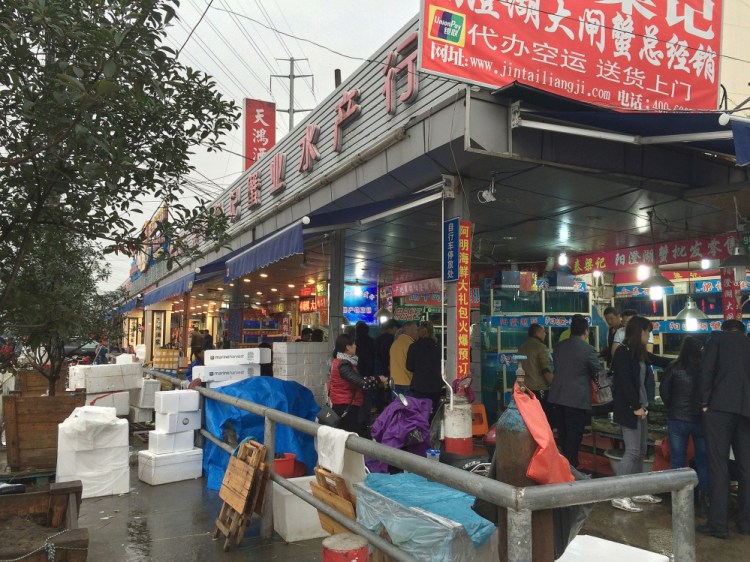Maine’s lobster industry is on pace for its best year ever, having sold $103 million worth of lobster abroad in the first half of 2016.
That’s more than twice as much as the $48.3 million it sold over the same period in 2015, and is even better than in 2014, when Maine had sold $54.7 million worth of lobster by July and ended the year with a record $365.5 million in foreign sales.
State trade officials credit this year’s 113 percent jump in midyear exports to huge growth in Canadian sales, which is basically Maine helping to fill its neighbor’s global orders, and a 43 percent growth in exports to China.
That success isn’t a coincidence, said Jeff Bennett, a senior trade specialist at the Maine International Trade Center. While the industry has enjoyed record catches over the past few years, that alone doesn’t equal higher exports.

Lobsters exported from Maine are transported in Shanghai last year. Exports from Maine are booming, and one of the biggest factors is the growth in shipments to China – from just $100,000 worth of lobsters in 2010 to $20 million in sales last year and another $5.8 million to Hong Kong. Photo by Jeff Bennett
“The fishery itself has worked hard to establish itself as a sustainable one, and that goes a long way with consumers and buyers,” Bennett said. “And the dealers have really knocked themselves out building the Asian market.”
The growth in the Chinese market has been remarkable. In 2010, Maine exported just $100,000 worth of lobsters to China. Last year, Maine sold $20 million in lobsters to China and another $5.8 million to Hong Kong.
“That is remarkable growth in such a short time,” Bennett said. “It’s all because of the dealers. It was an unfamiliar species to the Chinese, and the dealers had to educate them, in person, over time. Now it’s the future of the industry.”
Annie Tselikis, executive director of the Maine Lobster Dealers’ Association and spokesman for Maine Coast Co. in York, said Maine exporters laid the foundation for this Asian growth more than a decade ago.
“This export business did not happen overnight,” Tselikis said. “Many lobster companies invest considerable resources in attending trade shows around the world in places like Boston, Brussels, Hong Kong, Qingdao and Busan.”
FOR ONE BUSINESS, HARD WORK PAYS OFF
A decade ago, John and Brendan Ready had just entered the business, ready to use their business degrees to turn the lobstering they had learned on an uncle’s boat into a career. The 20-somethings wanted a global strategy.
Though lobster was huge in Maine, the state crustacean represented a tiny slice of the world diet, John Ready said. They believed the big money was to be found overseas.
At the time, most established lobster dealers were happy to sell domestically, with some exports heading to Europe, Maine’s biggest overseas market. But as the world economy slowed, Europe’s lobster market quickly dried up.
The Readys already had started to export. They had made the jump to a 24-hour Portland operation, with a driver hauling truckloads of lobster to John F. Kennedy International Airport and Newark Liberty International Airport every night and salesmen prepared to sell all night to different time zones.
Making the jump to Asia was risky, but it has paid off tenfold, Ready said.
“It’s about logistics for us as much as lobsters now,” Ready said. “That is where you make your margin. At the heart of it, it’s about the lobster, of course, its taste and its story, but getting it there, keeping it fresh, that’s our business.”

They expanded their sales force, got their Portland operation certified for direct exporting and built a processing plant in Scarborough to minimize the financial hit when their Asian-bound lobsters don’t make it on to overcrowded flights.
That missed Asian flight? Happens at least once a week, even now, Ready said.
The amount of travel required was staggering, Ready said. His brother, Brendan, spent more time overseas than he did stateside that first year they entered the Asian market, he said. He spent $100,000 in airfare alone.
Ready spends as much money now entertaining Hong Kong, Beijing and Shanghai customers here in Maine, selling them the Maine lobster experience to build customer loyalty.
When Ready first started, they sold 100,000 pounds of lobster a year. Now, there are some nights when they sell that much to Asia in one night. And Chinese New Year, once Ready’s slowest time of the year, is now its busiest.
COMPETITION AFTER TRADE DEALS
While the dealers have led the way, Maine International Trade Center has done its part to promote the brand. It led a trade mission to Shanghai and Tokyo last October, bringing along several lobster dealers.
Of course, lobster, from tails to rolls, was the highlight of every reception.
Although Asia’s appetite for lobster is on the rise, it’s not always Maine lobster. The trade data show that midyear sales to Korea are down 54 percent this year from last year at the same time, and 2015 Korean sales are down 61 percent.
Korean importers who had developed a taste for Maine lobster a few years ago, driving a sudden spike in exports, are now buying their lobster from Canada, which is the same species but landed a few hundred miles to the north, Bennett said. That shift follows the completion of U.S. and Canadian free trade deals, he said.
In 2012, the U.S. negotiated its trade deal with Korea, eliminating tariffs and duties and making our lobster much cheaper than Canada’s, Bennett said. That advantage faded in 2015 when Canada signed its own Korean trade deal.
Despite the uncertainty of a possible ban of live lobster exports to the European Union, state trade officials believe the European market is slowly starting to turn around after near collapse during the global recession a decade ago.
Send questions/comments to the editors.



Comments are no longer available on this story